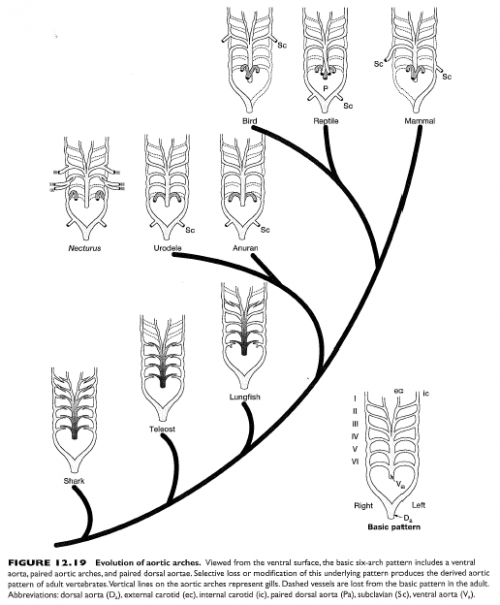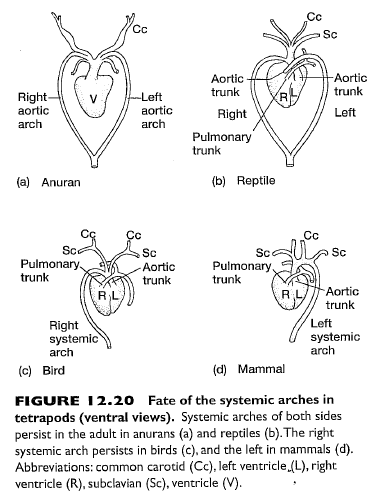Summary of problems:
There are good examples of the functional intermediate stages in the evolution of the mammalian heart. Explore Evolution repeats inaccurate and long-debunked creationist claims about the impossibility of evolving a four-chambered mammalian heart from a three-chambered reptilian heart. Though extensive research exists into exactly how this transition took place, Explore Evolution ignores the research, and abandons intellectual inquiry in favor of creationist talking points.
Full discussion:
Explore Evolution claims:
any transition from a three-chambered heart to a four-chambered heart requires a series of coordinated physiological and anatomical changes, including: 1) lengthening and attaching the existing septum to create a new, separate ventricle chamber, 2) replacing the forked abdominal aorta and two aortic arches with a single aorta, 3) rerouting the pulmonary arteries and veins, and 4) making various secondary structural changes to the walls and valves between chambers.
The need to change so many anatomical features and still maintain function at every step along the way raises some difficult questions about the viability of a series of transitional stages between a three- and four-chambered heart. Would the new chamber arise before the new veins, arteries, and septa? Would it arise before or after the new, single aorta emerged and the new plumbing was rerouted to support it? If the new chamber arose before these other features, how would it work? If it arose after the other features, what are the odd that all these new structures veins, arteries, septa, and aorta would fit together properly and function in concert with the new chamber?Explore Evolution, pp. 130-131
 4-Chambered and 3 Chambered Hearts: All that is fundamentally required to get the topology of the mammalian four-chambered heart from a reptile-like three-chambered heart (e.g. B, although this should not be taken as an exact representative of the ancestral state) is extension of the septum (the wall dividing the chambers and lost of the right systemic arch. The lineage leading to crocodiles evolved a four-chambered heart along a different pathway, keeping both systemic arches. From Figure 9-5, p. 112 of: Farrell, A. P. (1997). "Evolution of cardiovascular systems: Insights into ontogeny". Development of cardiovascular systems: molecules to organisms. Burggren, W. W. and Keller, B. B., Eds. Cambridge, UK ; New York, NY, USA, Cambridge University Press: 101-113.
4-Chambered and 3 Chambered Hearts: All that is fundamentally required to get the topology of the mammalian four-chambered heart from a reptile-like three-chambered heart (e.g. B, although this should not be taken as an exact representative of the ancestral state) is extension of the septum (the wall dividing the chambers and lost of the right systemic arch. The lineage leading to crocodiles evolved a four-chambered heart along a different pathway, keeping both systemic arches. From Figure 9-5, p. 112 of: Farrell, A. P. (1997). "Evolution of cardiovascular systems: Insights into ontogeny". Development of cardiovascular systems: molecules to organisms. Burggren, W. W. and Keller, B. B., Eds. Cambridge, UK ; New York, NY, USA, Cambridge University Press: 101-113. Rather than addressing the research that has been done on precisely these questions, Explore Evolution changes subjects, discussing hypotheses from evolutionary developmental biology, and citing a series of papers which do not actually address heart evolution. Yet again, this approach is not inquiry-based, and presents students with an inaccurate view about the way to approach uncertainty in science. The question of whether mutations affecting the early development of the heart might allow multiple changes to happen at once is a question which has to be addressed with evidence in that system, not with arguments about the evolution of novel body-plans, or hand-waving discussions of evolution in the Cambrian. There has been substantial work done on the development of the heart, and it is that literature which the authors of Explore Evolution should have reviewed (for example, Antoon F. M. Moorman and Vincent M. Christoffels. 2003. "Cardiac Chamber Formation: Development, Genes, and Evolution", Physiological Reviews 83:1223-1267).
 Liem's Hearts: This diagram shows a side view of the organisms, with the head facing left and heart and lungs to the right. The highly derived patterns of birds and mammals were formed by loss or specialization of the various arches. The order of events leading to each lineage has been reconstructed in some detail. As the caption says, "One of the hallmarks in comparative anatomy is the discovery and broadly based explanation of the evolutionary pattern of the heart and great vessels of vertebrates. It still has profound and pervasive implications in comparative biology."
Liem's Hearts: This diagram shows a side view of the organisms, with the head facing left and heart and lungs to the right. The highly derived patterns of birds and mammals were formed by loss or specialization of the various arches. The order of events leading to each lineage has been reconstructed in some detail. As the caption says, "One of the hallmarks in comparative anatomy is the discovery and broadly based explanation of the evolutionary pattern of the heart and great vessels of vertebrates. It still has profound and pervasive implications in comparative biology."From pp. 620-621 of: Liem, Karel F. and Walker, Warren F. (2001). Functional anatomy of the vertebrates: an evolutionary perspective. Fort Worth, Harcourt College Publishers. online source
The shift from three chambers to four chambers is not as large a leap as it might seem. The ventricles of the mammalian heart are separated by a thin muscular septum (wall) which grows out of the muscular sides of the heart. There is a similar septum in the reptilian and amphibian hearts, and as the figure above or even the figure in Explore Evolution illustrates, the transition from three chambers to four would not be at all problematic for the organism. The septum would grow longer, until it entirely separates the two sides. This change prevents oxygenated blood returning from the lungs from mixing with oxygen-depleted blood from the body. In species with slower metabolisms, or which (like amphibians) can exchange gases through their skin, the separation of oxygen-rich and oxygen-depleted blood is less critical, while in species with higher metabolic requirements, there is more intense selection acting on variations which improved oxygen flow to the body. Species with lower metabolisms can go for long periods without breathing, and in those settings, can restrict flow to the lungs, and use the full power of the heart to circulate the blood through the body. For those species, a three chambered heart allows needed flexibility. Mammals with high metabolic requirements cannot go as long without breathing, so there is no need to limit blood flow through the lungs in the same way.
Explore Evolution offers no explanation of why the aortic arch could not have evolved independently of those changes within the heart. Luckily, scientists are not as incurious as the authors of Explore Evolution, and have actually conducted research to better understand the evolution of the aortic arch and other blood vessels. In Functional Anatomy of the Vertebrates, Liem et al. explain:
One of the hallmarks in comparative anatomy is the discovery and broadly based explanation of the evolutionary pattern of the heart and great vessels of vertebrates. It still has profound and pervasive implications in comparative biology.Karel F. Liem, et al. (2001) Functional Anatomy of the Vertebrates, Harcourt College Publishers:Fort Worth, p. 620
 Evolution Aortic Arches: In this depiction, the viewer is facing the chest (ventral side) of the organism. The birds and mammals are actually very similar to reptiles in their fundamental pattern, except that they have lost the left or right systemic arch, respectively. From: Figure 12-19, p. 461 of: Kardong, Kenneth V. (2006). Vertebrates: comparative anatomy, function, evolution. Boston, McGraw-Hill Higher Education.
Evolution Aortic Arches: In this depiction, the viewer is facing the chest (ventral side) of the organism. The birds and mammals are actually very similar to reptiles in their fundamental pattern, except that they have lost the left or right systemic arch, respectively. From: Figure 12-19, p. 461 of: Kardong, Kenneth V. (2006). Vertebrates: comparative anatomy, function, evolution. Boston, McGraw-Hill Higher Education.  Aortic Arches: This diagram "zooms in" to show just the fate of the aortic arches in amphibians, reptiles, birds, and mammals. The diagram clearly indicates (unlike the diagram in Explore Evolution) that the only fundamental topology change between reptiles and mammals is that mammals have lost the right systemic arch. From Figure 12-20, p. 462 of: Kardong, Kenneth V. (2006). Vertebrates: comparative anatomy, function, evolution. Boston, McGraw-Hill Higher Education.
Aortic Arches: This diagram "zooms in" to show just the fate of the aortic arches in amphibians, reptiles, birds, and mammals. The diagram clearly indicates (unlike the diagram in Explore Evolution) that the only fundamental topology change between reptiles and mammals is that mammals have lost the right systemic arch. From Figure 12-20, p. 462 of: Kardong, Kenneth V. (2006). Vertebrates: comparative anatomy, function, evolution. Boston, McGraw-Hill Higher Education. An understanding of the details of this evolutionary process require more anatomical background than is appropriate for a high school class, let alone this review, which leaves one wondering why Explore Evolution raises the matter. The contrast between the confusion expressed by Explore Evolution and the detailed explanation offered by professionals in the field is a strong sign that Explore Evolution is not drawing its evidence from the biological literature, and is not interested in encouraging students to undertake genuine inquiry.
In fact, the basis for their claims about the aortic arches is most likely to be Michael Denton's Evolution: A Theory In Crisis (1985, Adler & Adler Publishers: Chevy Chase, MD), which spends several pages arguing the implausibility of evolutionary explanations of heart and aortic arch anatomy. Denton was instrumental in inspiring the intelligent design creationist movement, and Evolution: A Theory in Crisis was cited in Of Pandas and People, the intelligent design textbook ruled too religious for science classrooms as Explore Evolution was being written.
While scientists continue to research the evolution of the heart, producing and testing hypotheses, creationists continued to emphasize whatever uncertainty they could find. An intelligent design creationist group claims the evolution of the heart as an unsolvable problem Until 2005, the group hosting that claim "require[d] that club leaders be Christians," and their discussion of the issue reveals that their claims about the heart are not scientifically grounded. Even while acknowledging that "the 4 chamber mammalian heart probably isn't irreducibly complex" (as Explore Evolution intimates), they express certainty that "it might still be the result of intelligent design and not evolution, and irreducible complexity doesn't have to exist in all instances for it to exist in some." This is not critical thinking, and is not inquiry-based learning.
This argument, like its antecedents in the openly creationist literature, is a religious attack on evolution, not a scientifically grounded investigation. Explore Evolution argues that we know nothing unless we know everything. That attitude is both scientifically and pedagogically inappropriate. The evolutionary process leading to the forms of modern mammalian, reptilian, crocodilian and amphibian hearts remains a subject of research. Students interested in that ongoing research need a solid understanding of evolution, anatomy, physiology, and developmental biology, but more importantly, they need to understand how scientists know what they know, how scientific inquiry works. Explore Evolution will teach students none of this.
